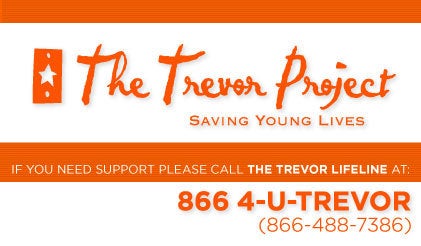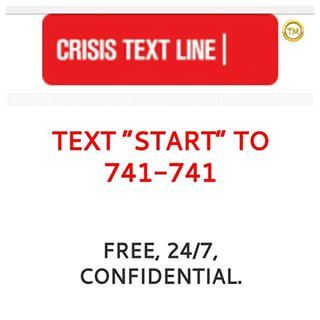
This week I had the privilege of speaking with experts, activists, and advocates about the various mental health needs we have in the LGBTQ communities, at an event hosted by Crisis Text Line. We all agreed that a supportive and continuous, therapeutic relationship is key, for everyone really. But for those of us who face constant discrimination it can be a matter of life and death. The trouble is that psychotherapy is stigmatized; not enough clinicians are competent, curious, or empathetic enough to make a connection with LGBTQ clients; and too many people simply can’t afford therapy, or their insurance won’t cover it (if they even have insurance). The experts I spoke to all fight tirelessly against these obstacles, in order to connect people to the safe, loving, and supportive relationships they need and deserve.
For this segment of my Pride in Mental Health Series, I talk with David Bond, Vice President of Programs at The Trevor Project, (the leading national organization providing crisis intervention and suicide prevention services to LGBTQ+ youth), and Shoko Morikawa, Crisis Counselor Supervisor at Crisis Text Line (which provides 24/7 text support to those in crisis, text 741741 for free).
What are the mental health needs of the LGBTQ people who contact your crisis counselors?
David Bond: This is a huge huge question. They are so wide and varied. On one spectrum, we need to stop pretending that sexual minorities and gender minorities are the same population. We come together for advocacy and support and allyship of each other, but for research purposes and intervention purposes those things are really distinct because the stressors are very, very different, and the trauma can be very, very different. So, education and advocacy are immensely important [in identifying the specific mental health needs of the people who contact The Trevor Lifeline, Trevor Chat, or Trevor Text]. If you look at the National Institute for Mental Health, and all the funding they provide for research, less than one half of 1 percent of all NIH funding goes to LGBT issues and 80 percent of that goes to HIV/ AIDS, there’s a tiny sliver of funding that goes toward research of any LGBT healthcare issue whatsoever, and almost none of that goes to minors. So there’s this population of people who are completely not understood. Closeted youth never get studied because...no closeted youth is going to sign up for a research study, since they’d need to have parental consent. So we need to have a better understanding of the funding sources and avenues to research these communities to really understand their resiliency, what they’re going through, and how to intervene in the most effective kinds of ways.
Shoko Morikawa: I know that at Crisis Text Line, roughly half of the people who text in [44 percent] are LGBTQ+. It’s great that we can reach that many people from those communities. They mostly talk about family, depression, suicide. Compared to people who text in who do not identify as LGBTQ+, they are more likely to talk about bullying, [4.7 times the rate of CTL’s general population], school [4.3 times the rate], and emotional abuse [3.6 times the rate]. Those who identify this way also tend to be a lot younger, under the age of 25. And the majority of these texters tend to talk about issues that are more generally about bullying, or family rejection, and less about being LGBT or Q, directly. They don’t tend to text about issues like coming out or gender identity. [It’s more to do with not fitting in and/or being abused, emotionally and/or physically, at home and/or at school]
In addition to the crisis counseling your organizations provide for those who text and call into your hotlines, what types of long term services do you connect them to?
Shoko Morikawa: We’re a short term service: conversations will last about an hour. Which is generally enough time for our trained crisis counselors to listen and validate whatever that person texting in is going through. And then helping them calm down, identifying their strengths, and helping them brainstorm next steps, and more ways to cope with what’s going on. Our goal is to bring them from a “hot moment” to a “cool calm” [i.e., use techniques in empathetic listening to build rapport and trust, and explore the texter’s issues and goal, so that they can collaboratively problem-solve to develop a plan to stay safe.]
Since we are a national organization, we don’t always have specific referrals [for therapists and other mental health professionals] though we are growing those lists, state by state. But we do refer people to organizations like The Trevor Project, The Trans Lifeline, GLSEN.
David Bond: Crisis services are meant to be episodic. Even if someone calls six times, they’re not necessarily seen as our client at the organization. It’s framed as, that person had six episodes of a moment of care. Although we will follow people over time. But what’s complicated for many people is to identify where those local resources are, depending on where they are in the country, they may have to travel two states away to find an LGBT center. So we do work very hard to try to find mental health resources, and if we can’t identify them, we work with people especially young people to think about all the people in their lives and who is the most supportive, who cares about them the most. Really try and help them to realize that there might be alternative ways of thinking about the people who are in their life. Because some of them may be much more supportive than you would assume.

David, you brought up a crucial point earlier, which is that a great deal of LGBT youth are not out. So how do we prepare teachers, guidance counselors, parents, and other adults, to at least provide a safe environment for those who are closeted and too afraid to seek help?
David Bond: The Trevor Project has these resource posters that are meant for classrooms and healthcare organizations, as part of the crisis intervention and peer support resources that we provide for free. There’s this little tiny rainbow sliver that goes through the middle of it. And I say to educators all the time,"If you have something like this in your classroom, it sends a tacit communication to the person in your classroom who might be struggling, that you might be a safe person to have a conversation with about all these things." I used to tell, teasingly would tell other mental health practitioners, "In your office you need a great big book that says 'LGBT' on it, or 'Gay' or 'Trans.' And you don’t even have to read the book. You just need to have it on the shelf, so that a client could come in and see your office might be a safe place to talk about it." Because doing a safety assessment of, I mean doing a coming out safety assessment is incredibly important. You hear these messages all the time that, “Everyone just needs to come out.” But the truth is if you’ve done a strong safety assessment, then it’s not necessarily a protective factor at all.
The youth who reach out to the Trevor Project, only about 50 percent are out to at least one parent. But 90 percent of them are out online. So it’s also important to create safe online spaces that are non-sexualized, that provide opportunity for young people to meet each other and build systems of support. If you think about that Trans girl of color in rural Arkansas, who doesn’t feel that there’s any one around her who understands. And she needs to find an online space, for example, that will give her access to other people like her so she doesn’t feel so isolated.
How do you get the word out about your service?
Shoko Morikawa: We use a lot of press at the schools all across the nation. With high schools, grade schools, and colleges as well. We also have partnerships with various city-based organizations, such as The Golden Gate Bridge and the CalTrain System in San Francisco. They help us get the word out by having billboards, especially at places like train stations, where we know that suicide attempts take place.
At the schools we have our Crisis Text Line posters, or our cards with our number on it, that school counselors can hand out to kids. We also have a lot of social media and national press coverage.

What would help to make mental health services more available, accessible, and appealing for people in need?
Shoko Morikawa: More discussions about mental health for sure. With our text line we have exchange 40 million messages the past 3 ½ years. So we’re also reaching a lot of people. And
the great thing about being a texting service is that it’s private and for that reason it is a great way to increase conversations about mental health awareness. We always “fight” [for the texter] during lunch times, because many young people who may seem to their peers like they’re texting their friends or something like that at the lunch table, are actually texting about an eating disorder, or about a family conflict. And especially for LGBTQ+ texters, it’s a great way for them to get help if they’re not out. They don’t want to be overheard. And by text it’s safe, silent, private, and accessible. And we’re 24/7 so you can text during your lunch break. When you get up in the morning. At 2am when you get up and go back to sleep. We’re always there. I think we’re making steps toward having those conversations more and having [mental health] become more accessible.
David Bond: Suicide is the second leading cause of death for all young people, between the ages of 10 and 24. And I always get the question, “What’s number 1?” It’s motor vehicle accidents. So since the year 2000, we’ve been able to decrease motor vehicle fatalities in this country between 35- 40 percent. And that’s because of policy change. We have bicycle helmet laws and seat belt laws and zero tolerance for drinking and driving, and texting and driving and we have enhanced crosswalks, and we have car seat laws for infants. Fatalities have been reduced by 35-40 percent, in just 17 years. Yet we’re not engaging in massive large scale public education about suicide prevention. Even though it’s number 2. And the big problem around this is the stigma. Because if someone has an accident or if someone has a physical health disease, people can blame the disease. But when people have mental health struggles. Or people are struggling with depression or thoughts of suicide, it’s not a disease model of blame. People are blaming the people who are feeling that way, who are suffering, saying, “Why don’t you snap out of it?” And, we need to have a real shift in the public health conversation in this country about mental health issues so you respect them in the same way that health care issues are respected.
You also have to identify the problem. So the other major problem that the LGBT community is suffering from is that we’re not being counted. So there’s a national violent death recording system that records all violent death in most states throughout the country. So they’ll know how somebody died. If they don’t collect the information about sexual orientation or gender identity, death investigators. Death certificates don’t say...they will say veteran status. So we know how veterans die. They’ll say male or female. So we get, “Well men die from some of these things, women die from some of these things.” But the whole country has absolutely no concept of how LGBT people die. So when we talk about research that we need to protect ourselves, to protect the community from death by suicide and mental health issues, we have to be counted. So it’s census. It’s death investigators. It’s a number of other ways.
At Trevor we do quite a bit of advocacy around this. We work on trying to change that scenario for the science. We work on bans for conversion therapy on a state by state basis. Successful in five states that ban conversion therapy for minors, as well as other municipalities. We also work on having states implement legislation that requires all of their schools to have suicide prevention policies. And those are LGBT inclusive, as well as other vulnerable populations. So we need policy interaction, but we also need more research. I mentioned earlier the NIH funding? Leukemia 30 years ago had a 90 percent mortality rate. It now has a 90 percent survival rate. The change was every leukemia patient participated in research and their doctors submitted it. Research led to treatment which led to cures, which created a huge shift in life. Because of research and advocacy.
*This post originally appeared on Mark O’Connell, LCSW-R’s Psychology Today column, “Quite Queerly.”
LGBTQ+ Mental Health Resources:
Crisis Text Line (Text 741741 for free, 24/7) http://www.crisistextline.org/who-we-are/
The Trevor Project http://www.thetrevorproject.org/
Psychology Today Therapist Finder https://therapists.psychologytoday.com/rms/?tr=Hdr_SubBrand Refine your search based on therapists' experience with people who are LGBTQ+
New York City-Based Resources:
The LGBT Center https://gaycenter.org/
Callen-Lorde http://callen-lorde.org/our-services/
Lighthouse LGBT (LGBTQ Affirmative Therapist Network) http://www.lighthouselgbt.com
Institute for Human Identity Therapy Center http://www.ihitherapy.org
